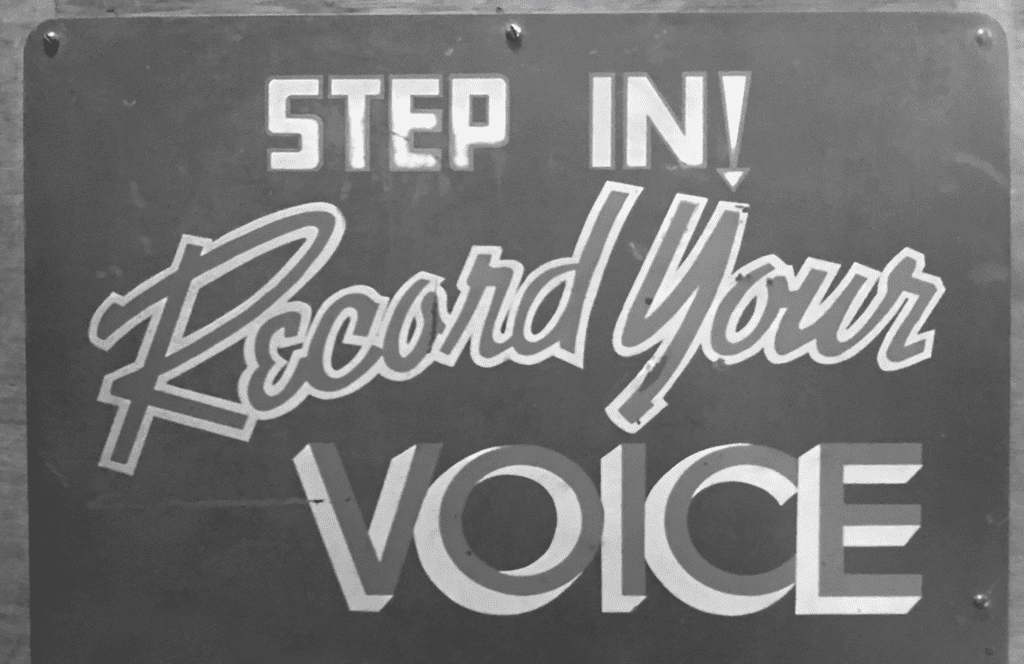Since we started planning this facility in 2010, I have been on a quest to come up with some cool “vintage” artwork to decorate the studio’s stairwell and hallways. Along the way, though, I have found myself really hampered by the fact that until much more recent years, recording studios and recording, generally, were not “consumer facing” products.
If you step into the average well decorated man-cave or garage workshop, you’d likely find at least one vintage sign for a beer company such as Budweiser or Guinness, maybe an automobile-related product such as motor oil or gasoline, or a grocery store brand such as Wonder Bread or Good Humor ice cream.
Those items all have one thing in common — their ubiquity as mass-marketed products sold at retail. If your bar sold Budweiser, you’d put a sign in your window to encourage people to drink it. If you were hoping to get shoppers to take home some ice cream, hanging a Good Humor sign from the front awning of your corner market would encouraged them to buy it. So there’s A LOT of these items floating around, even if they command huge premiums on eBay as collectibles.
[blockquote blockquote_style=”boxed” align=”center”]But we’re not a garage or a man-cave. We’re a recording studio.[/blockquote]
Large recording studios were almost exclusively owned by record labels until fellow WSDG client (I love calling him that) Jimi Hendrix opened Electric Lady Studios in 1970. These facilities might advertise in trade magazines, but they had no need for a sign on every street corner inviting Mr. or Mrs. Public to stop in and make a recording. You might find smaller recording facilities in towns across America, but these facilities did not have the budget, brand, or name recognition to advertise themselves through much more than ads in the local newspaper. So while you might find vintage advertising for record labels (the famous “Nipper the RCA dog” logo being a good example) or consumer audio gear (such as the Motorola Radio sign that has adorned our stairwell since 2017), I didn’t imagine I was going to find vintage advertising that seeks to entice consumers to “MAKE A RECORDING NOW!” It just didn’t seem like “a thing.”
Then I came across an incredible, little remembered retail recording product — one that harkens back to a much earlier era in the history of recorded sound.
Until the early 1950s, when reel-to-reel tape decks began to find their way into American homes, the only practical way for most consumers to make recordings was on a record disc. The home phonograph was a standard consumer device available in homes all over the world, so sharing material in a common format wasn’t a problem. The issues that the home phonograph was almost exclusively a playback only device. Few consumers needed or wanted to own the expensive, specialized equipment necessary to record a record disc.
Enter International Mutoscope Corporation of Long Island, New York.
The company first went into business in the 1920s making new motion picture short films for the already-obsolete but still popular mutscope “flip book” movie machines common at penny arcades and amusement parlors around the country. The company quickly branched off into all sorts of other coin-operated machines, including fortune tellers (think “Zoltar” from the Tom Hanks movie, “Big”), grip strength testers, pinball machines, and “Photomatic” photo booths.
In 1941, Mutoscope introduced their first model of their latest coin-operated device — the “Voice-O-Graph”. Based on an earlier machine designed by European inventor Alexander Lissiansky, the Voice-O-Graph was a phone booth sized “automatic recording studio” where patrons could step in, drop a quarter in the slot, and record a 65-second, 78 RPM record that could be played on a standard turntable.
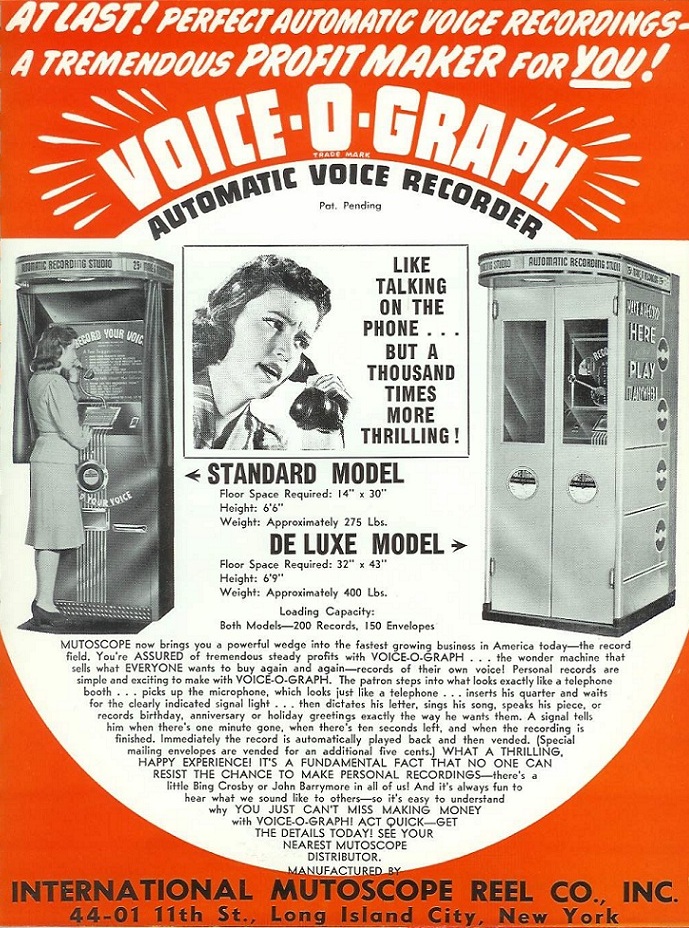
The Voice-O-Graph was marketed as a way for families to stay in touch across the miles; to send sung birthday greetings; for sailors and soldiers to send recorded greetings home to family; for songwriters to make quick “demo” versions of their songs; and, yes, just for the sheer novelty of hearing your own voice “as others hear you”.
[blockquote blockquote_style=”boxed” align=”center” text_align=”center” cite=”- Early 1940s Voice-O-Graph Trade Ad”]IT’S A FUNDAMENTAL FACT THAT NO ONE CAN RESIST THE CHANCE TO MAKE PERSONAL RECORDINGS–
There’s a little Bing Crosby or John Barrymore in all of us![/blockquote]
The devices could be found in arcades, state fairs, and boardwalks across America until well into the 60s. Even the Empire State Observatory had a machine.
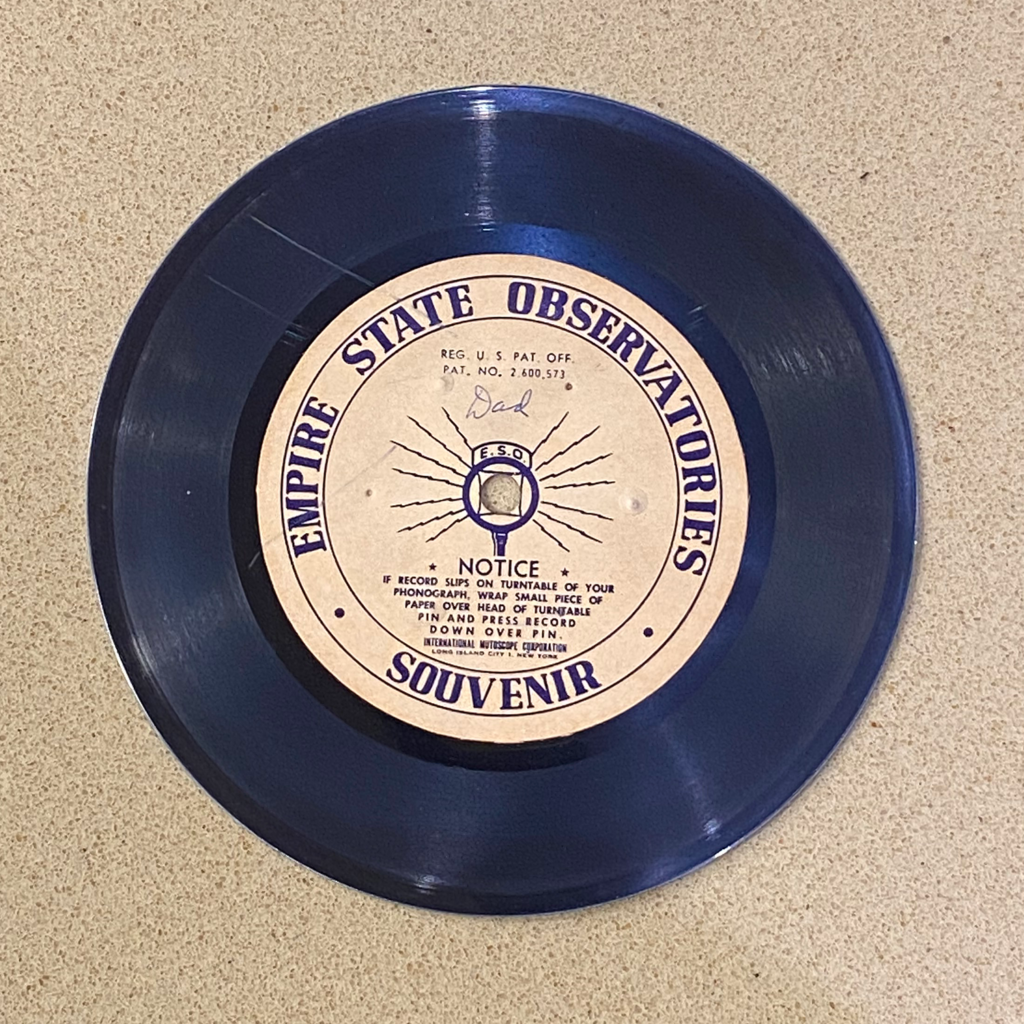
Note the “transmission” lines radiating from the microphone at the center of the record. Why, it’s as if you’re broadcasting from the top of the Empire State Building, just like real broadcasters do!
I’ve never had a good sense of whether the “novelty wore off,” or if, more likely, there simply became faster, easier, and cheaper ways for ordinary consumers to make and share their own recordings. International Mutoscope stopped making the machines in 1957, around the same time that reel-to-reel tape was making significant inroads into the home market. Pinball and jukebox manufacturer Williams Company produced one final version of the Voice-O-Graph in 1960, but with the arrival of cassette tapes in 1963, the end of the Voice-O-Graph as a viable retail product had finally arrived. Obsolete and often in very bad shape due to exposure to the elements on boardwalk piers and other outdoor venues, many Voice-O-Graph units were simply set out for the morning trash.
But the Voice-O-Graph never truly disappeared, and with the resurrection of interest in all things vinyl starting around 2006, slowly, collectors and vinyl fans began to rediscover these long lost mini recording studios in basements and warehouses. Bethesda, Maryland patent attorney Bill Bollman, an avid collector and restorer of old coin-operated devices, began restoring and reselling vintage units. Jack White of the White Stripes was a big fan of the Voice-O-Graph, and had a specially restored unit added to the Nashville location of his record label-slash-record shop, Third Man Records. There, visitors could have “the recording studio experience” just by stepping into a phone booth. Rocker Neil Young even recorded a whole album, A Letter Home, on the Voice-O-Graph machine at Third Man Records.
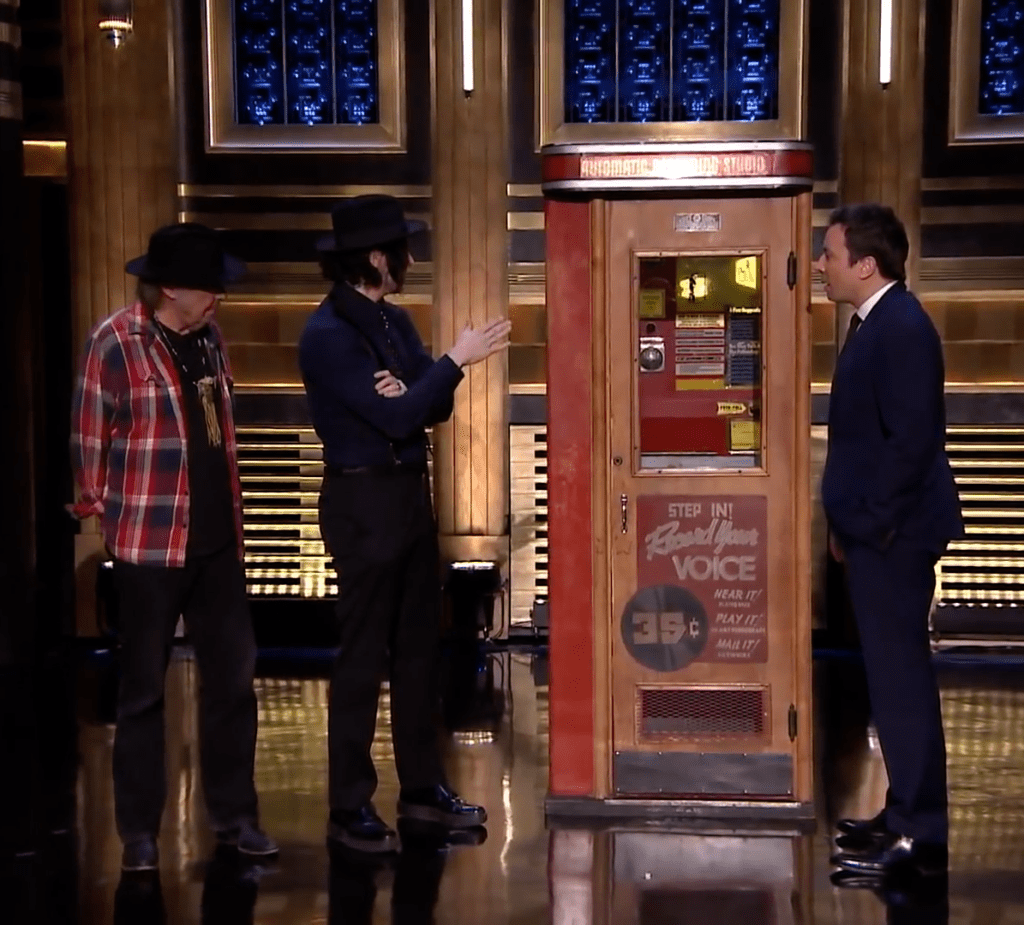
And yes, now even “The House That Jimi Built” – Electric Lady Studios — has its own Voice-O-Graph machine.
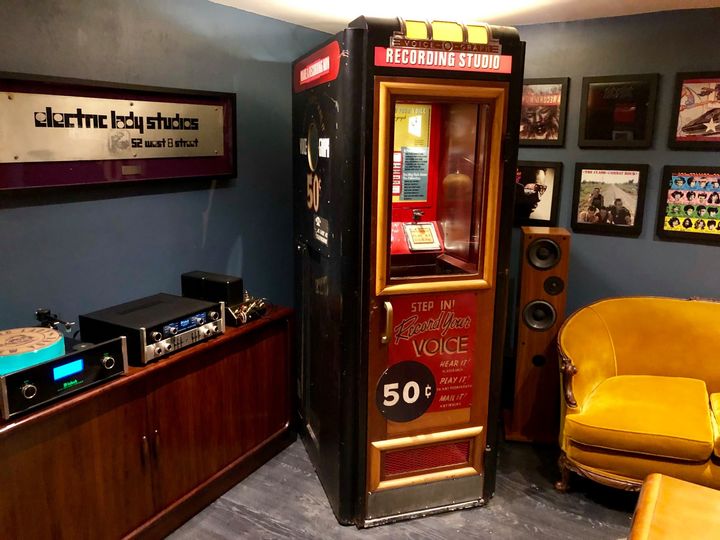
Regular readers of this blog will certainly understand that I find the Voice-O-Graph units — heck, the whole concept — to be incredibly cool. An automated recording studio, controlled by a jukebox-like mechanism — what’s not to like?
That said, I have always had to reassure my wife that I have no interest whatsoever in owning a Voice-O-Graph — not at the price that these units go for. When I last checked a few years ago, refurbished units were selling for an eye-watering $100K. Whew. I appreciate the history of vinyl & was an avid collector at one point in my life, but I’ve never come anywhere near close to really getting back into vinyl. As such, the Voice-O-Graph is a vintage technology I greatly appreciate but enjoy from a reasonable distance.
[blockquote blockquote_style=”boxed” align=”right” text_align=”center”]An automated recording studio, controlled by a jukebox-like mechanism…
So cool.
But at $100K for a restored unit, the Voice-O-Graph is something I only enjoy from a distance.[/blockquote]
Still, I find the Voice-O-Graph’s advertising artwork and “trade dress” to be incredibly cool. Why? I think it’s because the Voice-O-Graph was such a niche product — an automated recording studio. There are endless supplies of vintage motor oil, soft drink and grocery store signs that are great for a basement rec room, garage workshop, or “man cave”. But they’re completely unrelated to what we do here at ULS. For us, none of it is “on brand.”
And if you’re looking for similar vintage advertising for your recording studio, you’re going to be looking for a very long time. Why? Because in those days, recording studios were not a consumer product. You might find some old trade magazines extolling the virtues of the latest & greatest microphone, if you really know where to look. But you’re going to have a hard time finding consumer-facing, vintage advertising that has anything to do with studios.
I think the other thing I love about the Voice-O-Graph’s marketing materials is the earnestness of a past era, combined with the “gee whiz” factor that seemed to be such a massive selling point in mid-century America. I think it’s kind of funny to decorate our studio with signs implying that our customers are visiting us — an all-digital, 21st century, Pro Tools-based studio — to experience the “wonders” of modern recording technology as people thought of them in the 1940s.
[blockquote]”HEAR YOURSELF AS OTHERS HEAR YOU!”
What a concept. We are absolutely awash in sound in today’s world, and it’s difficult today to truly appreciate what a novelty it once was to hear your own voice as others heard you.[/blockquote]
So while I’m not interested in owning an actual Voice-O-Graph, I really like the vintage flavor of the advertising and signage associated with them. About two years ago, I did some poking around to see if I might be able to buy some of the metal signs from an abandoned unit. I had absolutely no such luck with that — the vintage market for these machines was so intense that any original “parts” — including the signage — were so in demand that I couldn’t find anyone willing to part with them.
That problem called for a different approach — one which, as a graphic designer, I enthusiastically decided to pursue.
In the Adams Morgan section of DC you’ll find the Songbyrd Music House and Record Cafe, a music venue, bar and restaurant that opened in 2014. The owners heard about Jack White’s Voice-O-Graph, and the record Neil Young made in it, and wanted one for their venue.
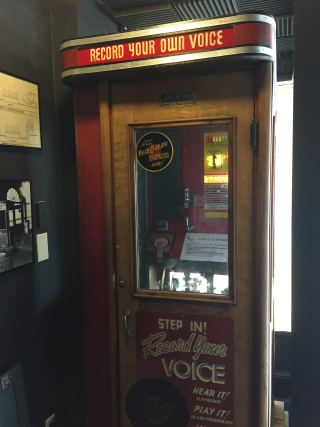
I stopped by one morning in December 2016 and, after buying a mocha and a sweet roll, asked if I might check out their Voice-O-Graph. They apologized & told me that the mechanism needed service and wasn’t currently working. (As an aside, this is yet another reason why I wouldn’t want to own an actual Voice-O-Graph — replacement parts for these units are spectacularly hard to find. By reputation, it seems keeping the units working is a constant battle against time, wear, and lack of parts. Even Third Man Records advises you to call first before stopping by the shop to record a disc.)
In any case, the staff at Songbyrd were happy to let me take some photos of the unit (I got the distinct impression, given how cool the Voice-O-Graph is in person, that I was not the first or the last patron to ever make such a request). So much cool artwork!
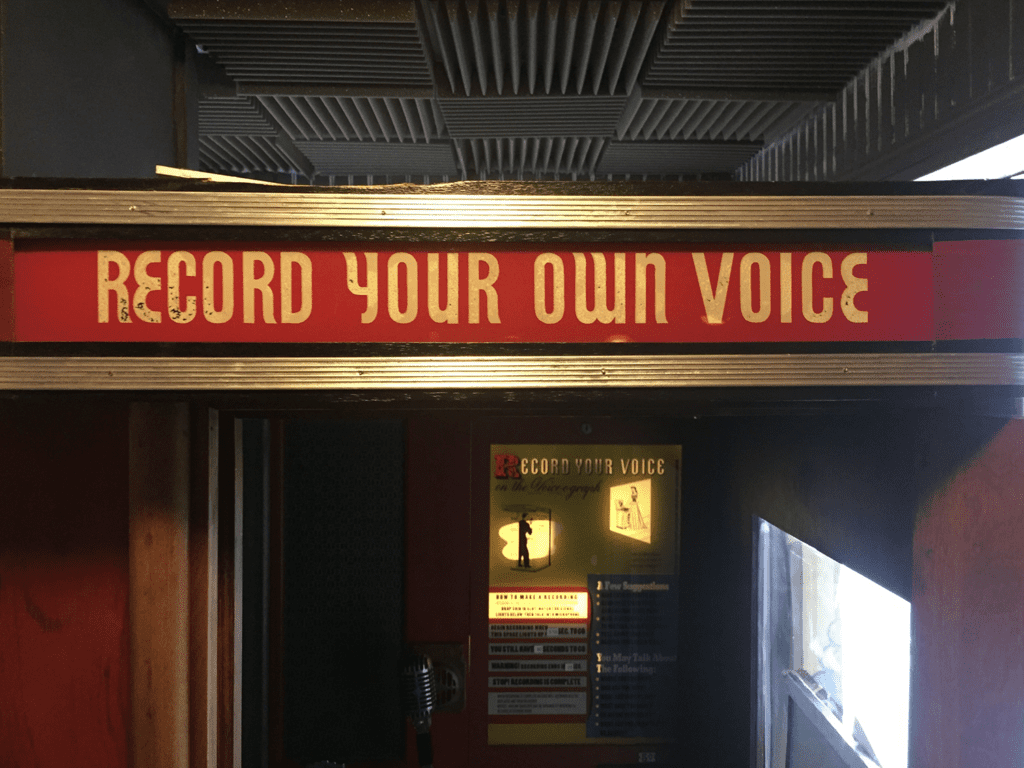
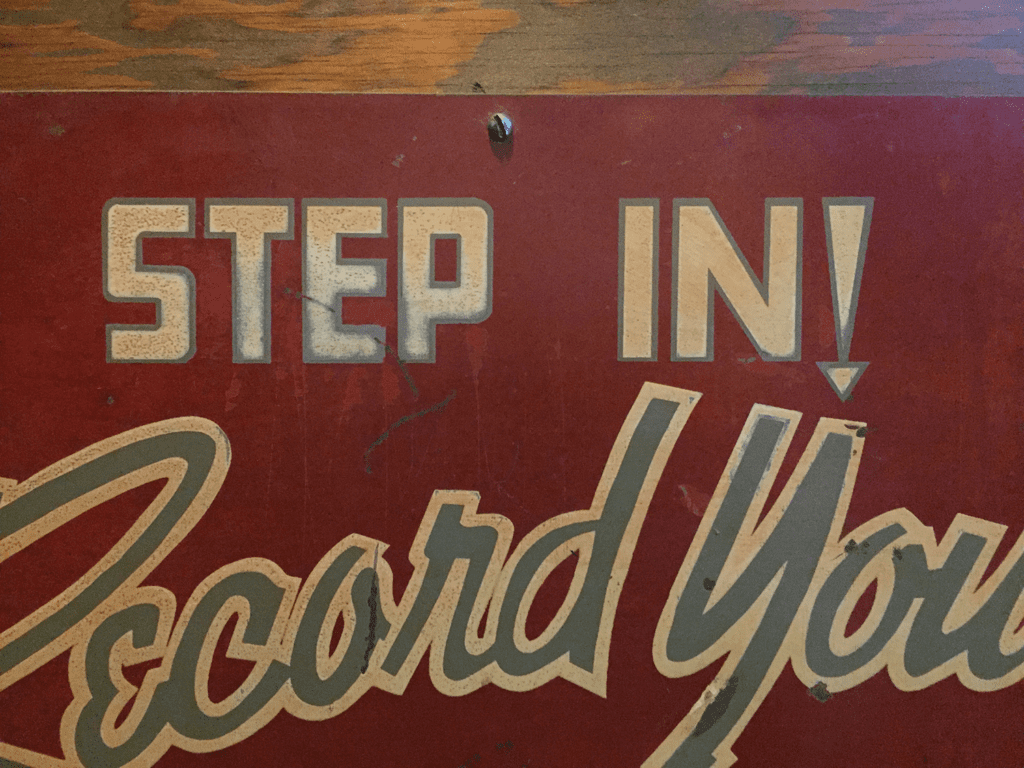
The sign was likely made using a multi-pass silkscreen painting process; note how the grey border around “STEP IN” is visible where the white fill of the letters has worn away. This pattern suggests the white was laid down on top in a later silkscreen paint pass. I used photos like this to get a better, high-resolution template for tracing in Illustrator.
Back at home at my desk, I used my collection of photos from my field trip to Songbyrd — along with some other examples I found on the Web — to painstakingly reassemble the first of what, I think, will be a series of Voice-O-Graph-related artwork for the studio stairwell and hallway: the red “STEP IN! RECORD YOUR VOICE!” sign from the door of a 1947 Voice-O-Graph.
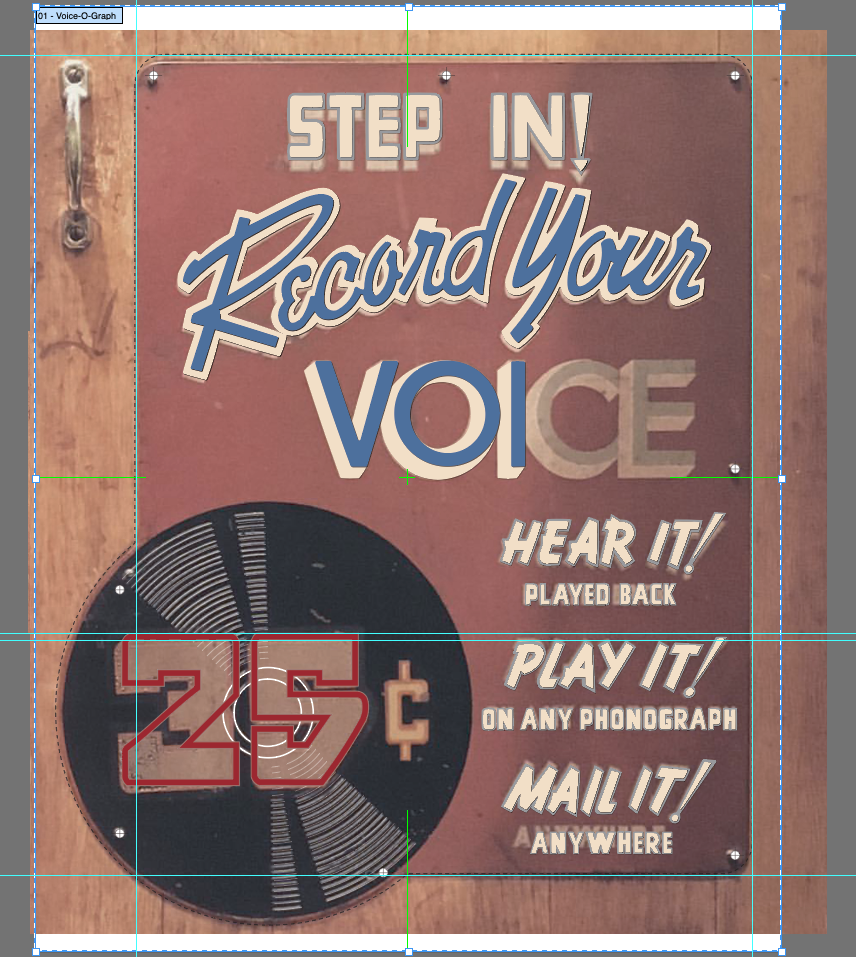
Next, I got in touch with a metal sign shop to make the sign for me. The actual sign from a real Voice-O-Graph is only about 18 inches wide, as it needs to fit on a fairly narrow door. Since I have a little more space to play with in the studio stairwell, and I’m not looking to install this sign on an actual Voice-O-Graph unit, I was looking for an oversize, poster-like version of the door’s artwork. The original signs were screen printed, but I know from making t-shirts that doing any kind of screen printing as a one-off is incredibly expensive and generally not something a commercial shop will do for you at any cost. So I went with a different, “digital” printing process, more akin to an ink jet printing process on metal, than screen printing.
I picked up the finished sign the other day. I am thrilled with the way it turned out!
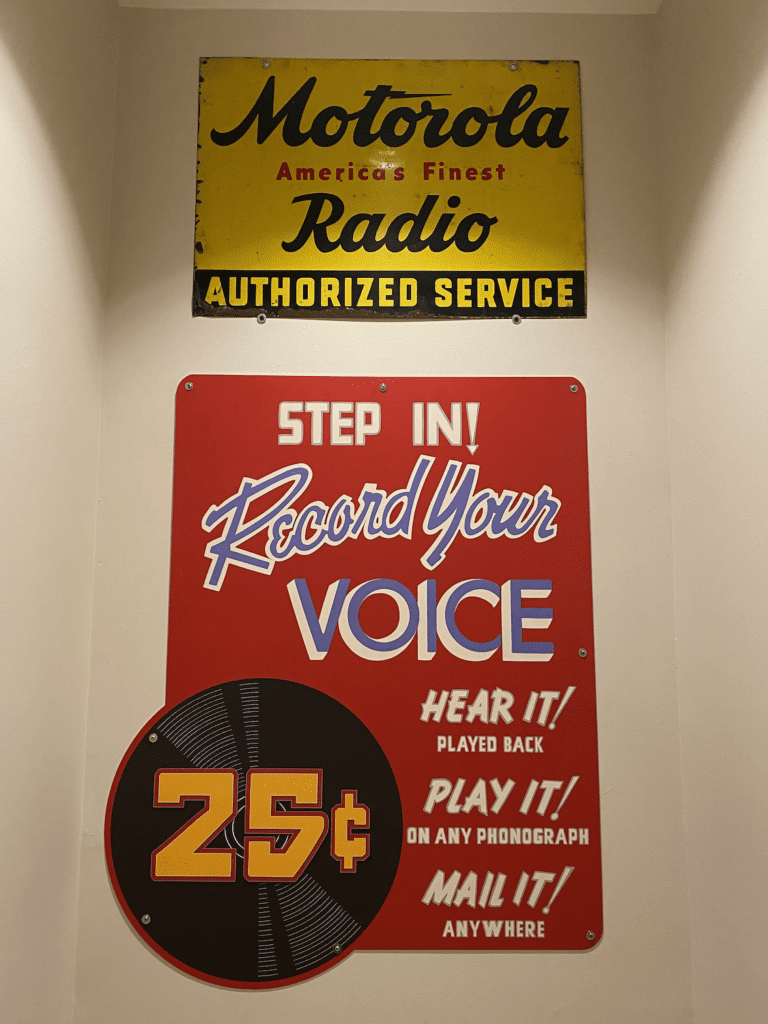
Not being a screen print, the texture is a little different, but each color still has a little “elevation” as if it was painted on. I mounted it on the wall just below the Motorola Radio sign in the studio stairwell.
With this first “proof of concept” out of the way, I’ve got some more Voice-O-Graph themed artwork to come, which I will write about in a future post. Stay tuned!
NEXT: We recreate the Voice-O-Graph’s “patent plate” as an oversize piece of brass artwork. Check it out!

